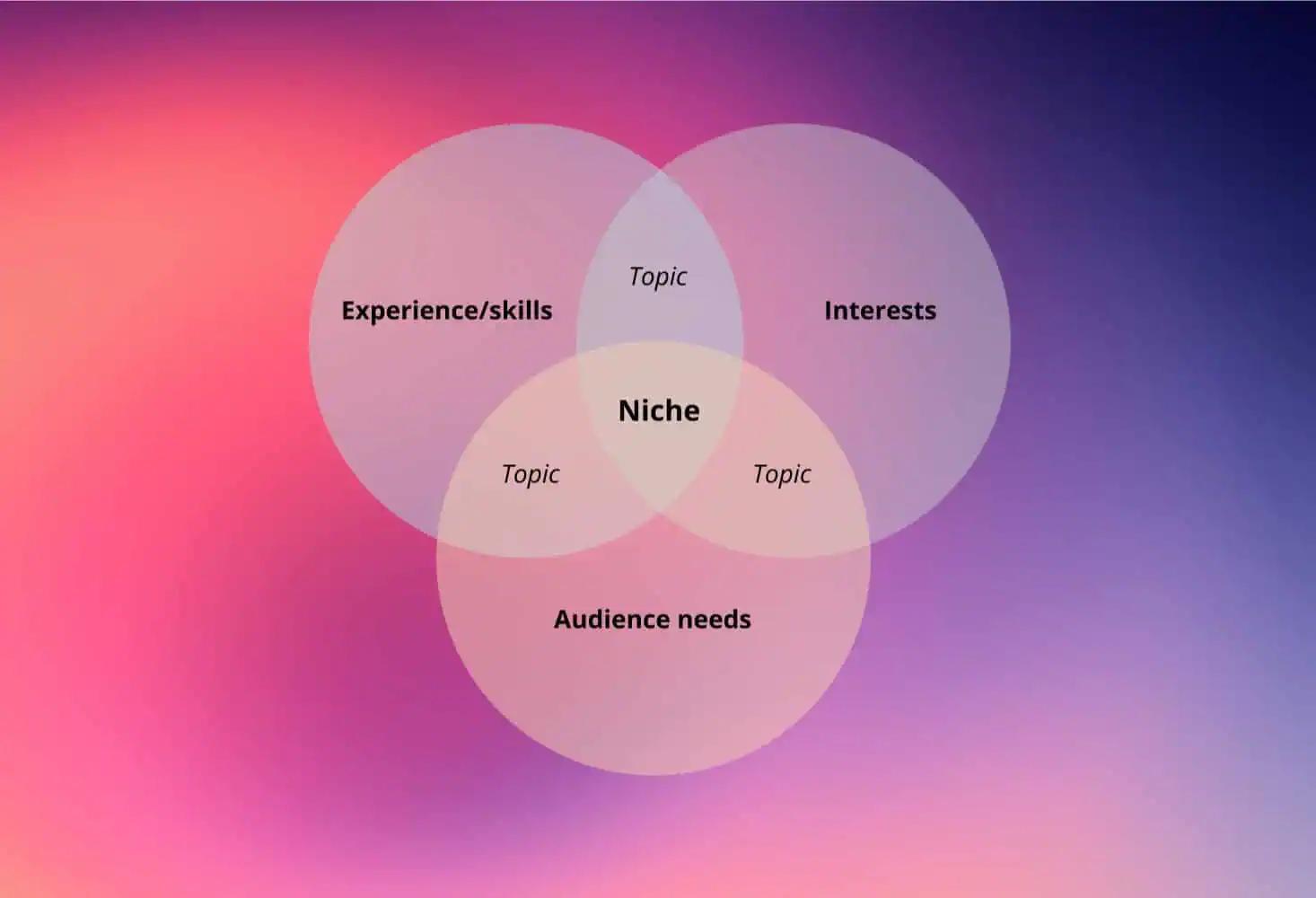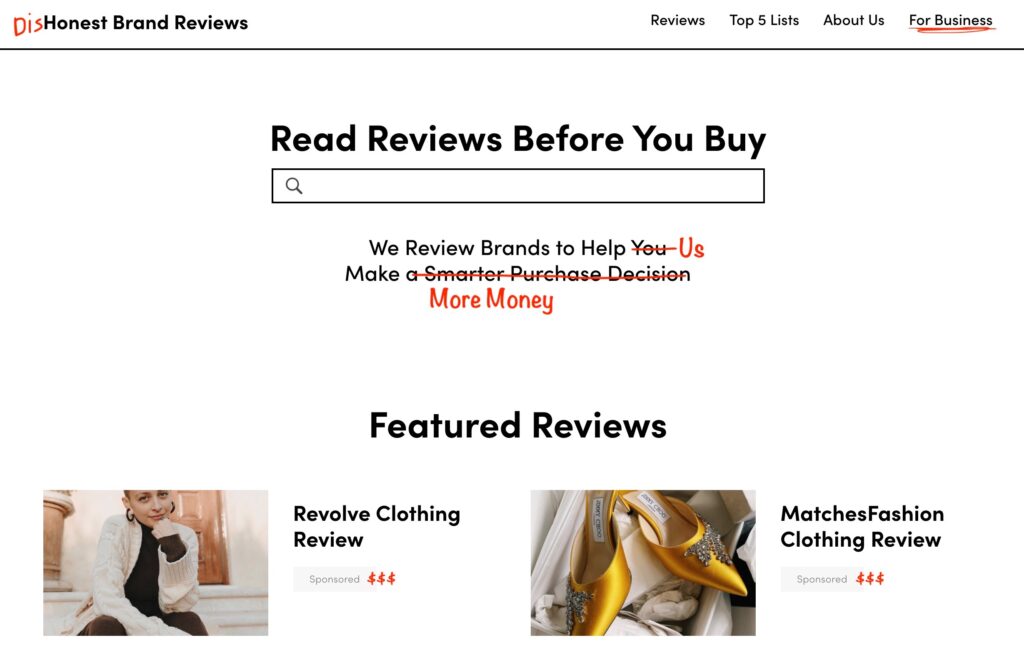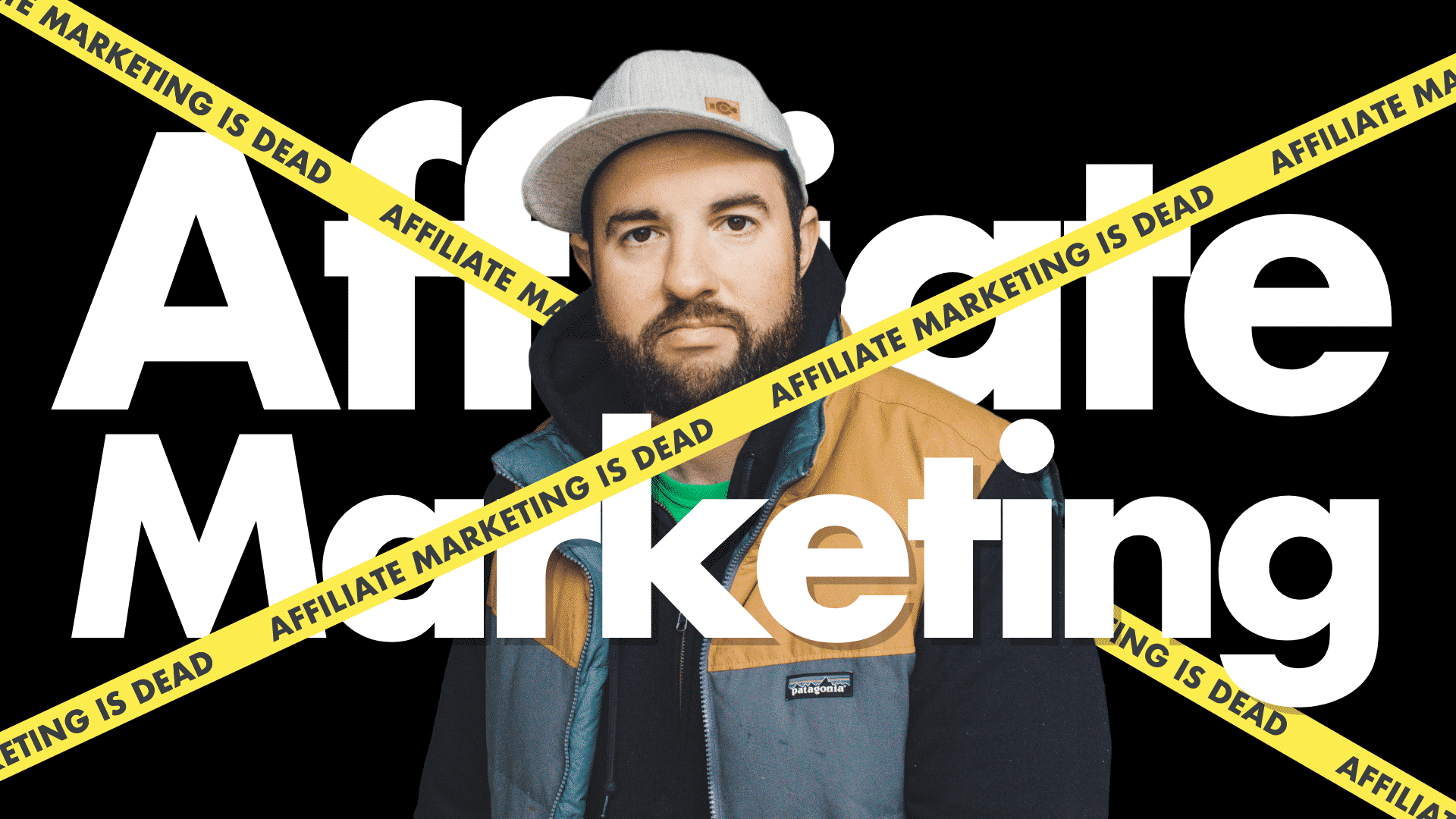The creator economy is exploding, but most creators are missing out on the affiliate marketing goldmine.
Trust me, after 8 years in the affiliate game, I know just how powerful this income stream can be.
Today, you'll get a crash course in creator affiliate marketing, covering all the essentials to get you started.
Keep reading…
What Is Affiliate Marketing?

Let's simplify affiliate marketing: You get paid to recommend products or services you believe in.
It works like this:
You share a unique link with your audience, and if someone purchases through that link, you get a commission.
It's that straightforward.
But there's a bit more to the ecosystem. Let's quickly break down the key players:
- Affiliate Networks: The matchmakers of the affiliate world. They connect creators like you with companies offering affiliate programs. Think Amazon Associates, ShareASale, and Impact.
- Affiliate Offers: The specific products or services you can promote. Each offer has its commission rate and terms.
- Affiliate Managers: Your point of contact who works for the company offering the affiliate program and can provide you with resources, answer questions, and sometimes even negotiate better rates for top performers.
These three work together to create the affiliate marketing ecosystem.
The network provides the platform, the offers give you something to promote, and the managers help ensure everything runs smoothly.
Now, affiliate marketing isn't new. For years, it's been a staple for websites and blogs looking to generate revenue.
But here's where it gets interesting:
It's found new life in the creator economy.
Why Creators Have an Edge in Affiliate Marketing
As a creator, you've got a secret weapon:
A personal connection with your audience.
They trust you and value your opinion. In the world of marketing, that trust is incredibly valuable.
Take video creators, for example.
Many have built strong personal brands on YouTube by being authentic on camera.
When they recommend a product, it carries weight. That trust often translates into higher conversion rates.
Affiliate marketing can be an evergreen monetization strategy for your creator business if you maintain integrity and avoid shady practices.
Now that we understand why affiliate marketing is so powerful for creators let's dive into the different types of offers you might encounter.
Different Types of Affiliate Offers
Alright, let's dive into the different flavors of affiliate marketing. Think of these as the main ingredients in your affiliate recipe:
- CPS (Cost Per Sale): You earn a commission when someone makes a purchase.
- CPL (Cost Per Lead): You're paid when someone signs up or provides contact information.
- CPA (Cost Per Action): You get paid when someone completes a specific action. Could be anything from downloading an app to filling out a survey.
Now, we're going to focus mainly on CPS in this article.
Why?
It's the most straightforward model for most creators to work with.
Plus, it's what you'll find on big-name networks like Amazon Associates, ShareASale, and Impact.
These networks are like all-you-can-eat buffets of affiliate offers. They've got something for everyone, making it easier to find products that fit your brand like a glove.
But here's the thing:
Not all affiliate networks are created equal. Some have a reputation that's... let's say, less than stellar.
Take ClickBank, for instance. Some of their offers, especially in the "make money online (MMO)" niche, might make you raise an eyebrow or two.
Why?
Because lots of affiliates promote these products for the fat commissions, not because they're good products.
And here's my two cents:
As a creator, your reputation isn't just important — it's everything.
So when choosing an affiliate network or deciding what to promote, be choosy. Seriously choosy. Don't just follow the money trail.
Ask yourself:
"Would I recommend this to my best friend?"
If the answer's no, it's a no-go.
Remember, trust is like a sandcastle — hard to build, easy to destroy. So always, always put quality first.
Your audience (and your future self) will thank you for it.
Choosing the Right Niche (for You)

Alright, let's talk about picking your niche.
It's not just about finding products to promote — it's about finding your sweet spot in the affiliate marketing world.
Think of it this way:
Your niche is where your passion meets your audience's needs. It's that simple but also that crucial.
Why Your Niche Matters
When you're in the right niche, everything else falls into place.
You'll enjoy creating content (or at least not hate it), your audience will love it, and those affiliate sales? They'll come more naturally.
But choose the wrong niche, and you're in for a struggle.
Trust me, promoting products you don't care about to an audience that isn't interested is no fun.
How to Find Your Niche
Finding your niche can be tricky. I've been there, struggling for years to "discover" the perfect niche.
But here's the truth bomb I wish someone had dropped on me earlier:
Many of us get stuck in this loop of endless research, hoping someone will point us to that golden niche that guarantees success.
But it doesn't exist.
The better approach?
Find the sweet spot where these three things intersect:
- What are you passionate about? If you don't care, your audience won't either.
- What are you good at? Your skills and knowledge are your secret sauce.
- Is there money in it? At the end of the day, this is a business.
Now, don't overthink this. Do a bit of soul-searching (just enough, not too much), and then…
…here's the kicker:
Just pick something and start.
Remember, if you're building a personal brand, you're not stuck in one niche forever. You can always pivot if things don't work out as expected.
The key is to start somewhere and learn as you go.
Look, I can't tell you exactly which niche to choose. But I can tell you this:
I know this is easier said than done, but I'm not just spouting some feel-good advice I read somewhere.
This comes from years of personal struggle and countless nights of second-guessing myself. It took me way too long to figure this out, and I'd hate to see you go through the same drawn-out process.
Learn from my mistakes, will ya? 😉
So, take a deep breath, pick something, and dive in. The water's fine, I promise.
Anyway, here's a video I absolutely love to make your soul-searching process a bit easier:
Building Your Affiliate Marketing Strategy

You've picked your niche. Now what?
It's time to build a strategy to make your affiliate marketing efforts work.
Don't worry — we're not talking about some complex, MBA-level business plan here. Just a solid roadmap to keep you on track.
Know Your Audience (Like, Really Know Them)
First things first:
Who are you talking to?
And I don't mean "women aged 25-34" or some vague demographic nonsense. I'm talking about understanding their hopes, dreams, fears, and favorite pizza toppings.
(Okay maybe not that last one, but you get the idea.)
Spend time where your audience hangs out online. Read their comments and join their discussions.
What keeps them up at night? What solutions are they desperately searching for?
This isn't just market research — it's gold for your content and affiliate choices.
Choose Your Affiliate Offers Wisely
Here's where a lot of newbies mess up. They see a product with a big-fat commission and think they've hit the jackpot.
Spoiler alert: that's not how it works.
Your affiliate products need to align with three things:
- Your niche (duh)
- Your audience's needs (double duh)
- Your personal values (yep, this matters too)
Remember:
Every product you promote is a reflection of you.
So, choose ones you'd happily recommend to your best friend, even if no commission was involved.
Let me tell you a story:
Early in my affiliate journey, I was active in CPA marketing and promoted an offer that brought in consistent daily commissions.
One day, a guy reached out to me, offering significantly higher payouts for the same exact offer. Without doing much research (because I thought I had nothing to lose), I decided to switch.
At first, things seemed fine. I didn't measure the exact difference in revenue, but it felt like I was making more.
However, after a few weeks, I noticed a massive decrease in conversion rates.
Even though the payout wasn't the highest with the first network, I was getting conversions like crazy. However, with the new network, conversions had become noticeably fewer.
When I finally checked the revenue reports a few months later, I realized I had made less money despite the network's higher payout.
It turned out the new network was scraping conversions on my account, which is, unfortunately, a common practice with some shady networks.
The lesson?
Don't be swayed by promises of higher payouts without doing your due diligence.
Sometimes, a reliable network with slightly lower payouts can be more profitable in the long run.
Always prioritize your audience's trust and your partners' reliability over short-term gains.
Content is King (But Distribution is Queen)
Great content is the backbone of your affiliate marketing strategy.
But here's the deal:
Even the best content is useless if nobody sees it.
So, plan your content, yes. But also plan how you're going to get eyeballs on that content. And here's a pro tip:
When you're just starting out, focus on mastering one platform first.
You might build an affiliate blog and dive into SEO or build a presence on YouTube or Instagram.
Whatever you choose, stick with it until you start seeing real traction.
Why?
Because content creation is tough (at least that's the case for me), especially in the beginning, you can give it your all by focusing on one platform without spreading yourself too thin.
It allows you to:
- Learn the ins and outs of the platform
- Consistently produce content without burning out
- Build a solid audience base
Once you've mastered your first platform and consistently create content, you can consider expanding.
Trust me, mastering one platform makes it easier to branch out later.
And in my case, here's what I'm doing:
I'm laser-focused on pumping out as many articles as possible on this blog before even thinking about another platform.
Why?
My website is the main base of everything I do. I own and have complete control of it.
A YouTube channel, on the other hand, is just one of the traffic sources I could utilize to reach my potential audience.
So while it's generally faster to start seeing traction with YouTube than with a blog, I still want to focus on blogging first because I'm in it for the long haul.
Plus, cranking out a written article is much less of a headache than producing a YouTube video. It's about playing to your strengths and building momentum.
Tracking and Optimization

Now, let's talk about something that might not be as sexy as creating content but is crucial: tracking and optimization.
Start with Analytics from Day One
Here's a pro tip:
Set up Google Analytics 4 (GA4) as soon as you launch your site. I mean it — day one, no excuses.
"But I don't have any traffic yet!" I hear you cry.
Trust me, you'll thank yourself later. Here's why:
- You'll have data from the very beginning of your journey.
- You'll get comfortable with the tool before you're drowning in data.
- You can make data-driven decisions right from the start.
Setting up GA4 might sound technical and intimidating, but it's not as hard as you think.
Here's a simple tutorial to get you started:
By the way, if for some reason, you find GA4 exciting and want to dive deep into it, Julius from the video above is your guy. I learned everything I know about GA4 from him.
What to Track
Once you've got GA4 set up, here are some key metrics to keep an eye on:
- Traffic sources: Where are your visitors coming from?
- Popular content: What pages are getting the most views?
- User behavior: How long are people staying on your site?
- Conversion rates: How many clicks are your affiliate links getting?
The point of all this tracking is more than just to have pretty graphs. It's to give you insights so you can improve your content and strategy.
Low traffic? Your SEO needs work.
High bounce rate? Your content might need to be more engaging.
Lots of views but few clicks? Your call-to-action (CTA) might need tweaking.
Remember:
Affiliate marketing isn't a "set it and forget it" kind of gig. It's an ongoing process of tracking, analyzing, and improving.
Creating Compelling Content for Affiliate Marketing

Let's talk about the meat and potatoes of affiliate marketing: your content. This is where the magic happens, folks.
Types of Content That Work
First things first, what kind of content should you be creating?
Well, the sky's the limit, but here are some tried-and-true formats:
- How-To Guides: Show how a product solves a problem.
- Roundup Posts: "Top 10 Tools for X" - super helpful for your audience.
- Product Reviews: Deep dives into the pros and cons of a product. Be honest!
- Comparison Posts: "Product A vs. Product B" - help your audience make informed decisions.
Now, all these formats work for both written and video content. The key is to pick your shit sandwich and stick with it.
If you love writing, pump out those blog posts. More of a video person? Fire up that camera and get rolling.
Stay focused on your chosen medium until you see some real traction.
Remember, the best type of content is the one you can create consistently and that your audience loves.
Don't force yourself to make videos if writing is your jam, or vice versa. It's all about playing to your strengths and building that momentum.
Value First, Promote Second
Your content must be valuable even if the reader never clicks your affiliate link. I know, sounds counterintuitive, right?
But trust me, if you focus on genuinely helping your audience, the sales will follow.
People can smell a sales pitch from a mile away, but they'll stick around for solid advice.
So how do you actually put this into practice? Let's break it down:
-
Solve Real Problems: Don't just talk about product features. Show how these features solve specific problems your audience faces.
The more practical, the better.
-
Be Brutally Honest: Don't shy away from mentioning product drawbacks. Paradoxically, pointing out flaws makes your positive points more credible.
-
Educate, Don't Just Promote: Use your content to teach your audience something new. It could be how to use a product more effectively or understand the tech behind it.
-
Share Personal Experiences: Nothing beats real-world usage. Talk about how you've actually used the product in your life or work.
-
Write for Humans, Not Search Engines: Look, I get it. SEO tools are shiny and promise top rankings.
But here's the truth: If you write primarily for search engines, your content will sound robotic and, frankly, boring. Then, one algorithm update, and poof, your entire site is gone.
Instead, focus on creating content that genuinely helps your audience. Yes, keep SEO in mind, but don't let it dictate your entire content strategy.
A real, engaged audience is worth way more than a high ranking for a search term nobody actually uses.
Here's a fantastic article about creating content that actually helps people:

Remember, building trust is a long game.
By consistently providing value, you're not just making a sale — you're building a loyal audience that will keep coming back (and clicking those affiliate links) because they trust your recommendations.
So before you publish that next piece of content, ask yourself:
"Would this be useful even without the affiliate link?"
If the answer is yes, you're on the right track.
Single Platform Strategy
While it's tempting to try to be everywhere at once, it can be more effective to focus on mastering one platform before expanding.
Blogs and YouTube are particularly well-suited for affiliate marketing:
- Blogs allow for in-depth content and are great for SEO
- YouTube allows for visual demonstrations and building a personal connection
Once you've established a strong presence on one platform, consider expanding to others.
Platforms like Pinterest and Facebook can be effective for driving traffic to your main content.
When expanding to multiple platforms, maintain consistency in your messaging and branding. This helps build a cohesive brand across channels.
Cross-Platform Content Strategy
As you expand to multiple platforms, consider how you can repurpose and cross-promote your content:
- Turn blog posts into video scripts (or vice versa)
- Create Pinterest graphics from key points in your content
- Share snippets of your content on social media to drive traffic to the full piece
This approach allows you to reach a wider audience while maintaining a consistent message.
Disclosure: It's Not Just Legal, It's Smart
Always, always, ALWAYS disclose your affiliate relationships.
It's not just about staying on the right side of the law (though that's important). It's about building trust with your audience.
A simple one should do the trick, and here's mine for your inspiration:
Informational vs. Transactional Content
Here's a common rookie mistake:
Turning every piece of content into a sales pitch. Don't fall into that trap.
Instead, think of your content strategy as a balance between informational and transactional content.
Informational Content
This is your bread and butter. It's content that educates, entertains, or solves problems for your audience without directly pushing a sale.
Think how-to guides, industry news, or in-depth explanations of complex topics.
Why it matters: Informational content builds trust, establishes your expertise, and keeps your audience returning for more.
Transactional Content
This is where your affiliate links shine. Product reviews, comparison posts, or "best of" lists often fall into this category.
The primary goal here is to help your audience make a purchasing decision.
Why it matters: This is how you monetize your audience's trust and generate affiliate income.
Understanding the Funnel
Here's where things get interesting:
Your content doesn't just serve different purposes — it serves different audiences at various stages of their journey.
Informational Content and TOFU (Top of Funnel)
Remember that informational content we talked about? It's gold for attracting people at the top of the funnel (TOFU).
These folks are just starting to explore a topic or realize they have a problem.
For example, someone googling "how to start a podcast" isn't ready to buy expensive mic equipment yet.
But your informational content on podcasting basics? That's right up their alley.
Transactional Content and BOFU (Bottom of Funnel)
On the flip side, your transactional content speaks to people at the bottom of the funnel (BOFU).
These folks know what they need and are ready to purchase.
Someone searching for "best podcasting microphones under $200" is much closer to making a purchase. That's where your product comparisons and reviews come in handy.
The Customer Journey
Here's the beauty of this approach:
Your informational content can guide people from TOFU to BOFU.
Someone who found your "podcasting for beginners" guide might come back months later, ready to invest in equipment and trust your microphone recommendations.
This approach does more than just chase quick sales.
It builds a pipeline of future customers and positions you as a trusted resource throughout their journey.
You're playing the long game here, and it'll pay off, I promise.
Finding the Right Mix
So, what's the perfect balance? While there's no one-size-fits-all answer, a good rule of thumb is the 80/20 rule:
- Aim for about 80% informational content
- Reserve about 20% for transactional content
This ratio keeps your audience engaged and prevents "affiliate fatigue" while still giving you plenty of opportunities to promote products.
Remember:
This is a long game.
A reader might come for a how-to guide today, remember your helpful advice, and return later to click an affiliate link when they're ready to buy.
Maximizing Your Affiliate Earnings

Now that we've covered the basics, let's delve into how you can maximize your affiliate earnings.
This isn't about quick tricks but rather a strategic approach to improving your results over time.
Improving Click-Through Rates (CTR)
The first step in increasing your earnings is getting more people to click on your affiliate links. This starts with creating compelling content, but it doesn't end there.
For written content:
- Craft irresistible titles that make readers' fingers itch to click.
- Just make sure your content delivers on that promise. Your title should be a teaser that ignites curiosity while your content satisfies it.
- For example, instead of "Tips for Better Sleep," try "The 3 AM Secret That Revolutionized My Sleep (And Can Change Yours Too)."
- Write in a conversational tone, adding your personal voice and experiences.
- With the rise of AI-generated content, a human touch helps your writing stand out and connect with readers.
- Use high-quality, relevant visuals. Avoid cheesy stock photos at all costs.
- Instead, opt for original images, well-crafted AI-generated visuals, or authentic photographs that truly complement your content.
For video content:
- Craft titles that are impossible to scroll past. Make them irresistible and add a touch of mystery.
- Instead of "Tips for Better Sleep," try "I Slept Like a Billionaire for 30 Days. Here's What Happened."
- The curiosity gap will have viewers clicking faster than you can say "subscribe."
- Thumbnails are your video's movie poster — make them pop!
- Use contrasting colors and clear imagery, and if you're comfortable, include a picture of yourself with an intriguing expression.
- For example, if your video is about a surprising investment strategy, your thumbnail could show you looking shocked with text like "This $50 changed everything!"
- Remember, your thumbnail should work in tandem with your title to tell a story.
- If you use text in your thumbnails, make it large and legible. Imagine someone scrolling on their phone — if they can't read it, they won't click it. Stick to 3-4 words max.
- Ensure your video content delivers on the promise of your title and thumbnail. The goal is to surprise and delight, not disappoint.
- If your title promises a life-changing sleep hack, your video better not be a generic list of "drink chamomile tea and avoid screens."
Remember:
The goal isn't to trick people into clicking but to accurately represent your content in an appealing way.
Advanced Tracking and Analysis
While basic analytics are essential, diving deeper into your data can provide valuable insights.
-
Event Tracking: Set up event tracking for all important actions on your site. This might include:
- Affiliate link clicks
- Email signups
- PDF (lead magnet) downloads
- Video plays (for embedded videos)
-
Custom Reports: Create reports in GA4 that focus on the metrics most relevant to your affiliate efforts.
-
UTM Parameters: Use these to track which specific promotional efforts drive traffic and conversions.
This data reveals which content, products, and strategies hit the mark.
This allows you to focus on what's working and improve or eliminate what isn't.
Diversify to Maximize (and Protect) Your Earnings
Remember when we talked about cross-platform strategy earlier? Well, it's not just about reaching more people — it's also about protecting your income.
Here's the deal:
Putting all your eggs in one basket is risky in any business, especially in the ever-changing world of online content.
Let me give you a real-world example:
Over the last few months, Google rolled out its Helpful Content Update (HCU) multiple times.
Sounds innocuous.
Well, it wiped out hundreds (if not thousands) of websites from search results overnight.
Content creators who relied solely on Google traffic saw their earnings vanish in the blink of an eye.
I'm not saying Google traffic is unreliable, but you shouldn't rely on it as your sole traffic source.
Once you've got a good handle on your primary platform, start thinking about diversification.
This could mean:
- Expanding to other content platforms (remember that cross-platform strategy we discussed?)
- Diversifying your traffic sources (social media, email marketing, etc.)
- Exploring different types of affiliate offers or different networks for the same offers
- Build out your email list — essentially the only online asset you own and have complete control over.
Diversifying efforts across platforms and traffic sources means maximizing potential earnings and building a safety net.
If one platform changes its algorithm or an affiliate program shuts down, you'll have other income streams to fall back on.
But this doesn't mean jumping onto every platform at once. Start with mastering one, then gradually expand.
Think of it as not putting all your eggs in one digital basket.
Common Pitfalls and How to Avoid Them

Even the best of us stumble sometimes. As you navigate the affiliate marketing world, it's helpful to be aware of common mistakes.
Think of this as your friendly neighborhood guide to avoiding the potholes on the road to success.
Oversaturation of Affiliate Links
One frequent error is stuffing content with too many affiliate links.
While it might seem logical to maximize click (and revenue) opportunities, this can make your content feel like a pushy salesperson.
Use links sparingly and naturally, focusing on quality over quantity.
Promoting Products You Have Never Used or Don't Believe In
It's tempting to recommend anything with a high commission, but your audience can sniff out insincerity.
Your authenticity is your secret weapon in affiliate marketing. Stick to promoting products you've used and genuinely endorse.
Chasing Big Bucks Over Sustainability
Many newcomers fall for the allure of high-paying offers without considering long-term viability.
Focus on building a sustainable business with quality products that meet your audience's needs. It's the tortoise approach in a world of hares.
Relying on a Single Traffic Source
Putting all your eggs in one basket is risky, especially in the ever-changing digital landscape, where platforms constantly update their algorithms.
Diversify your traffic sources by combining SEO with social media, email marketing, and other channels.
It's like creating a well-balanced diet for your affiliate business.
Depending on a Single Affiliate Offer or Network
Similarly, relying on one affiliate offer or network is like having only one item on the menu.
Programs can change or shut down unexpectedly. Networks can slash their commission rates massively, and you can lose 50% of revenue overnight.
Protect yourself by diversifying your affiliate partnerships, and here's a real-life story for your reference:

Expecting Instant Success
Affiliate marketing is more marathon than sprint. Patience and persistence are your best friends here.
Focus on consistently creating value and building relationships with your audience.
Lack of Transparency
Always be upfront about your affiliate relationships. Clear disclosure builds trust with your audience and keeps you on the right side of regulations.
It's not just good ethics; it's good business.
If you can avoid these common missteps, you'll set yourself up for long-term success in affiliate marketing.
Everyone trips up now and then. The key is to learn from those stumbles and keep pushing forward.
Next Steps

So, you've got the basics down. You're creating content, building an audience, and seeing those affiliate commissions roll in.
What's next?
Let's discuss some advanced strategies to take your affiliate marketing to the next level.
Shop Around for Better Deals
Don't settle for the first affiliate deal you find. Shop around. Many products are available through multiple networks or have their in-house programs.
Compare the offerings:
- Commission rates (higher is better, obviously)
- Cookie duration (longer means more potential earnings)
- Payment terms (faster payouts = happier you)
- Promotional resources (because who doesn't love free marketing tools?)
Negotiate Like a Pro
Once you've proven your worth as an affiliate, don't be shy about negotiating better terms.
You might be surprised what you can get if you just ask:
- Higher commission rates
- Custom landing pages
- Exclusive discount codes for your audience
- Extended cookie durations
Remember, you're providing value to these companies. It's okay to ask for value in return.
Timing Is Everything
Keep an eye out for seasonal promotions. Many companies offer increased commissions during peak seasons, such as holidays. Plan your content calendar to take advantage of these opportunities.
It's like catching a wave — ride it while it's there.
Level Up with Tiered Programs
Consider tiered programs too. Some affiliate programs offer increased commission rates as you drive more sales.
These can be particularly lucrative if you're consistently promoting a product.
It's like leveling up in a game — the more you sell, the more you earn.
The Power of Recurring Commissions
For subscription-based products, look for programs that offer commissions on recurring payments, not just the initial sale.
It's the gift that keeps on giving.
Why settle for a one-time commission when you can earn month after month?
Creating Your Own Products
But here's the real kicker:
When you reach this advanced stage, think about creating your own digital products.
Why?
Because then you have full control over what you're selling and promoting.
It's the ultimate way to ensure the reliability and sustainability of your online business. Plus, the profit margins on digital products can be pretty sweet.
Creating your own product might seem daunting, but remember — you've already built an audience.
You know what they want and what problems they're trying to solve. Use that knowledge to create something truly valuable.
Wrapping Up
Alright, folks, you've made it to the end of this crash course.
We've covered a lot of ground, from choosing your niche to crafting your affiliate strategy, avoiding common pitfalls, and even leveling up your game.
And I really hope you enjoyed this article as much as I enjoyed writing it.
Now, it's your turn:
Which part(s) or section(s) of this article did you find most helpful? Which stage or phase of your affiliate marketing journey are you in right now?
Drop them in the comments below. I'd love to hear about your journey and help out where I can :)


